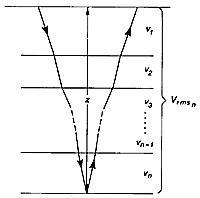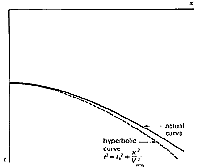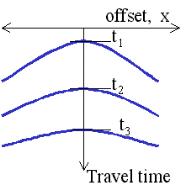| |
If there are additional layers then the seismic energy at each interface
is refracted according to Snell's Law. The energy no longer travels in
a straight line and hence the travel times are affected. It is observed
that for small offsets, the travel time curve is still approximately hyperbolic,
but the velocity, which controls the shape of the curve, is an "average" velocity
determined from the velocities of all the layers above the reflector. The velocity
is called the RMS (Root
Mean Square)
velocity, Vrms.
 |
 |
| (a) The complex travel path of a reflected
ray through a multilayered ground. (b) The time--distance curve
for reflected rays following the above type of path. Note that the divergence
from the hyperbolic travel-time curve for a homogeneous overburden of velocity
Vrms increases with offset.
From Kearey, Philip and Micheal Brooks, An Introduction to Geophysical
Exploration. 2nd ed. Blackwell Science: 1991. |
As outlined in the figure above, the reflection curve for small offsets
is still like a hyperbola, but the associated velocity is Vrms
, not a true interval velocity.

|
For each hyperbola,  |
By fitting hyperbolas to each reflection event one can obtain (tn,
Vnrms) for n = 1, 2, ... The interval velocity
and layer thickness of each layer can be found using the formula below.
These formulae for the interval velocity and thickness of the nth
layer are directly obtainable from the definition of Vnrms
given above.
The RMS velocity for the nth layer is given by,

where vi is the velocity of the ith layer, and
ti
is the one-way travel time through the ith layer.
© UBC EOS, D.W. Oldenburg and F. Jones |
|

